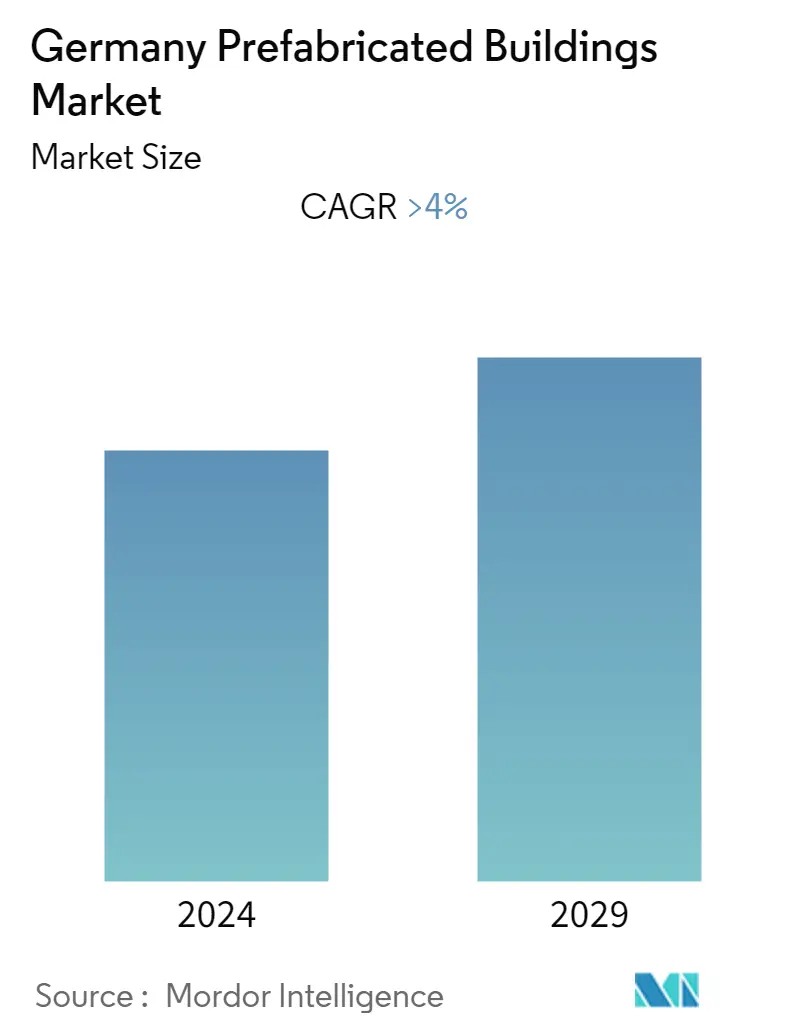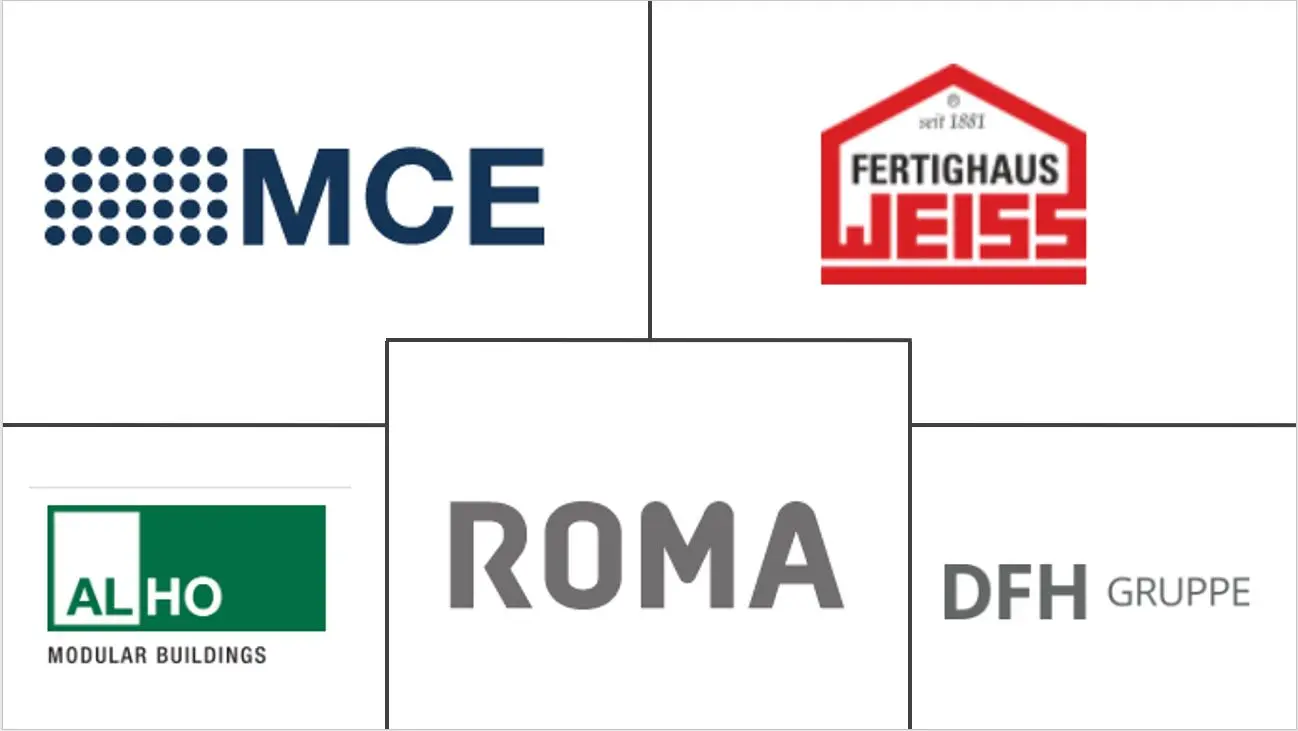Market Size of Germany Prefabricated Buildings Industry

| Study Period | 2020 - 2029 |
| Base Year For Estimation | 2023 |
| Forecast Data Period | 2024 - 2029 |
| Historical Data Period | 2020 - 2022 |
| CAGR | > 4.00 % |
| Market Concentration | Medium |
Major Players
*Disclaimer: Major Players sorted in no particular order |
Germany Prefabricated Buildings Market Analysis
The German Prefabricated Building Market is expected to record a CAGR of approximately 4% during the forecast period 2022-2027.
The COVID-19 pandemic has caused immense disruptions in construction works across Germany. With the fall in building and construction operations, the need for prefabricated building systems has fallen significantly, which has had a major impact on the market growth. Several construction companies shut down their projects due to lockdown and restrictions. Since a high workforce is required for traditional construction, opting for prefabricated buildings came out as an optimum solution during the pandemic. Due to the lockdown in the country, prefabricated manufacturing companies have faced a range of challenges owing to the shortage of raw materials and labor. The revenue of the prefabricated building market decreased drastically in 2020 due to covid 19. A slow recovery was seen in 2021 after the relaxation of lockdown norms.
Prefabricated housing is gaining popularity across the European region due to the population growth and shortages in housing. It is gaining momentum as an effective means to build affordable housing. Prefabricated housing demand is on the rise, as the building technique's advantages are increasingly being leveraged by new home buyers in an improving economic and demographically charged marketplace. The adoption of additive manufacturing in Europe is expected to significantly boost the prefabricated construction sector in Germany. Companies are embracing environment-friendly products and production practices to set themselves apart from the competition. The introduction of energy-absorbing materials such as micro dwellings has resulted from the focus on energy efficiency.
The rising awareness of construction wastage and its impact on the environment is encouraging the adoption of prefabricated buildings. Various interior and exterior architectural styles that cannot be realized in a house built on-site can be easily deployed in a prefabricated house. Technological progress and manufacturers' focus on providing customers with high-quality services can further promote the growth of the German prefabricated building market during the forecast period.
Germany Prefabricated Buildings Industry Segmentation
Prefabricated buildings, or prefabs, are buildings with components (walls, roof, and floor) that are manufactured in a factory or manufacturing plant. These components can be fully or partially assembled in a factory, then transferred to the construction site. The German Prefabricated Buildings Market is Segmented by Material (Concrete, Glass, Metal, Timber, and Other Material Types) and by Application (Residential, Commercial and Other Applications (Industrial, Institutional, and Infrastructure)). The report offers market size and forecasts for the German Prefabricated Buildings Market in value (USD billion) for all the above segments.
| By Material | |
| Concrete | |
| Glass | |
| Metal | |
| Timber | |
| Other Material Types |
| By Application | |
| Residential | |
| Commercial | |
| Other Applications ( Industrial, Institutional, and Infrastructure) |
Germany Prefabricated Buildings Market Size Summary
The German prefabricated building market is experiencing a transformative phase, driven by the need for efficient and sustainable construction solutions. The market, which faced significant challenges during the COVID-19 pandemic due to disruptions in construction activities and labor shortages, is gradually recovering. The pandemic highlighted the advantages of prefabricated buildings, such as reduced labor requirements and faster construction times, which have made them an attractive alternative to traditional building methods. The increasing demand for affordable housing, coupled with the adoption of additive manufacturing and eco-friendly practices, is further propelling the market's growth. Prefabricated housing is gaining traction as a viable solution to address housing shortages in Europe, with Germany at the forefront of this trend.
The market is characterized by a competitive landscape, with key players like ALHO Systembau GmbH, Romakowski GmbH & Co. KG, and Deutsche Fertighaus Holding leading the charge. The use of precast concrete is becoming more prevalent due to its cost-effectiveness and strength, although the availability of skilled labor to implement these systems remains a challenge. Government regulations and rising labor costs are shifting consumer preferences towards prefabricated buildings, which are manufactured off-site and assembled on location. Recent developments, such as the collaboration between Daiwa House Modular Europe and Capital Bay to establish a mega factory for modular homes, underscore the market's potential to address Europe's housing needs. The focus on energy efficiency and innovative architectural styles is expected to drive further growth in the German prefabricated building market.
Germany Prefabricated Buildings Market Size - Table of Contents
-
1. MARKET DYNAMICS
-
1.1 Market Overview
-
1.2 Market Drivers
-
1.3 Market Restraints
-
1.4 Value Chain / Supply Chain Analysis
-
1.5 Brief on Different Structures Used in the Prefabricated Buildings Industry
-
1.6 Porter's Five Forces Analysis
-
1.6.1 Threat of New Entrants
-
1.6.2 Bargaining Power of Buyers/Consumers
-
1.6.3 Bargaining Power of Suppliers
-
1.6.4 Threat of Substitute Products
-
1.6.5 Intensity of Competitive Rivalry
-
-
1.7 Impact of COVID-19 on the market
-
-
2. MARKET SEGMENTATION (Market Size By Value)
-
2.1 By Material
-
2.1.1 Concrete
-
2.1.2 Glass
-
2.1.3 Metal
-
2.1.4 Timber
-
2.1.5 Other Material Types
-
-
2.2 By Application
-
2.2.1 Residential
-
2.2.2 Commercial
-
2.2.3 Other Applications ( Industrial, Institutional, and Infrastructure)
-
-
Germany Prefabricated Buildings Market Size FAQs
What is the current Germany Prefabricated Buildings Market size?
The Germany Prefabricated Buildings Market is projected to register a CAGR of greater than 4% during the forecast period (2024-2029)
Who are the key players in Germany Prefabricated Buildings Market?
ALHO Systembau GmbH, Romakowski GmbH & Co. KG, MCE GmbH Niederlassung Rhein-Main, Deutsche Fertighaus Holding and Fertighaus Weiss GmbH are the major companies operating in the Germany Prefabricated Buildings Market.

